Google is constantly optimizing and streamlining the power supply architecture of its data center, removing the engine room-level UPS from the earliest customized high-efficiency PSU power supply, moving the UPS to the server motherboard, improving power supply efficiency and reducing room-level UPS investment and loss; As the power of the cabinet increased and the energy consumption was further reduced, Google switched to a 48V power supply architecture. In this direction, there was an excessive phase of 12V intermediate conversion in the middle. Until 2013, it was realized from the grid to 48V. The CPU's extremely compact architecture removes the room-level UPS, removes the cabinet-level 48V to 12V secondary conversion, and implements a 48V-to-CPU single-stage conversion at the server board level. Finally, in 2015, the lead-acid battery was replaced with The lithium battery finally realized the latest 48V full cabinet architecture.
The following picture is the introduction of Google's 48V cabinet at the OCP Summit.
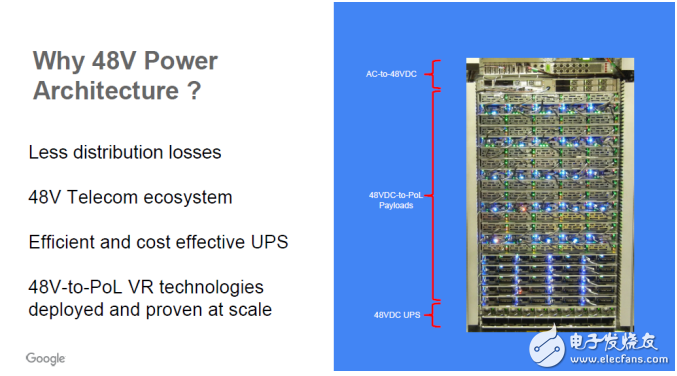
Google 48V cabinet layout
Google's half-cabinet height 48V power supply several features of the whole cabinet:1. The 48V power supply POL architecture reduces energy consumption by more than 30% compared to the traditional 12V server architecture, greatly reducing the energy consumption of the global cloud data center;
2, the use of a customized 48V power supply POL server, all server power supply from the 48V busbar rear side of the whole cabinet, the use of 48V bus can also support the future single cabinet power density increased to more than 50KW;
3. Place the 48V power supply enclosure on the top of the cabinet and connect the 48V lithium battery room to the bottom of the cabinet. It is estimated that the server temperature will affect the battery life.
4. The 48V-powered TOR switch is used to supply power to the switch by two smaller 48V power supplies. In fact, it can be configured separately.
5. The POL server adopts a mashup method, and some of them may be any configuration such as a CPU node, a GPU node, or a storage node;
6, 2U less than the height of the PSU box has 8 48V slots, installed 6 PSU power modules, consider 5 with 1 backup and UPS charging power, refer to the industry's typical 3KW high efficiency power module, estimated half cabinet The load is about 12 to 14 kW of peak power, and the power of the two UPSs will double in the entire cabinet.
The 7-48V UPS battery is also modular in design. It can select the required number of module batteries according to IT power and backup time. The above picture can fully support up to 10 battery packs.
8, Google has used this technology on a large scale for several years, the technology is very mature, the efficiency is high, and the cost is greatly reduced.
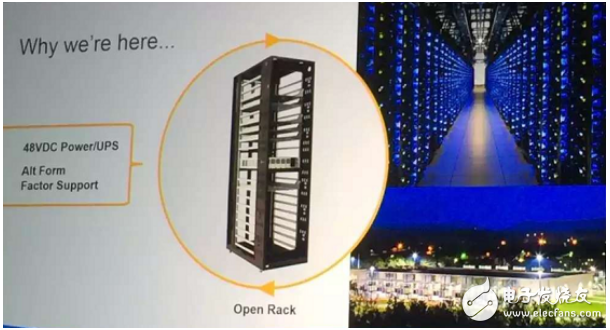
Google contributed to OCP's 48V power supply cabinet
Several features that Google contributed to OCP's 48V cabinet:1, 21 inches of internal width, can support various types of servers, but may be shorter in cabinet depth than the general OCP cabinet, so that more cabinet columns can be installed in the data center;
2, can be installed in various types of data centers, to meet the needs of various users and deployed in data centers around the world;
3, cold channel maintenance, the front side can be installed network cable, or optional 48V DC PDU;
4. The 48V UPS subrack is installed in the middle of the cabinet. The height of the 2U is the power supply space (excluding the battery). Six PSU modules are configured. If a typical 48V power module of 3KW is used, the cabinet power of up to 15KW can be supported.
5. Because the UPS architecture in the cabinet is adopted, the power supply level is directly supplied to the equipment room. The busbars at the top of the cabinet directly supply power to the entire cabinet. Plug and play, the power supply architecture is very simple and flat, and the efficiency and cost are better. .
6. If the server of other users still uses the 12V input motherboard, it can also meet the original 12V input server by adding a 48V to 12V DCDC converter in this 48V cabinet.
7. At present, Google has already submitted a new specification to the OCP for this new cabinet and 48V UPS technology, and added more choices to the industry.
The front part briefly analyzes the characteristics of the 48V whole cabinet. The whole cabinet comes with a 48V lithium battery BBU. It no longer needs the machine room level UPS. The power distribution structure is very simple, which can greatly reduce the investment and system energy consumption. Let's make a Simple energy efficiency comparison between the 48V full cabinet architecture and the traditional UPS power supply architecture.
Using the traditional UPS power supply architecture, the traditional system with PSU power supply per server is as shown in the figure below. From the power grid to the 12V server motherboard, about 22% of the energy consumption is wasted. Even in the traditional UPS architecture, even the current high-efficiency power supply system is adopted. The 12V motherboard from the mains to the server will also waste 6.4% of energy.
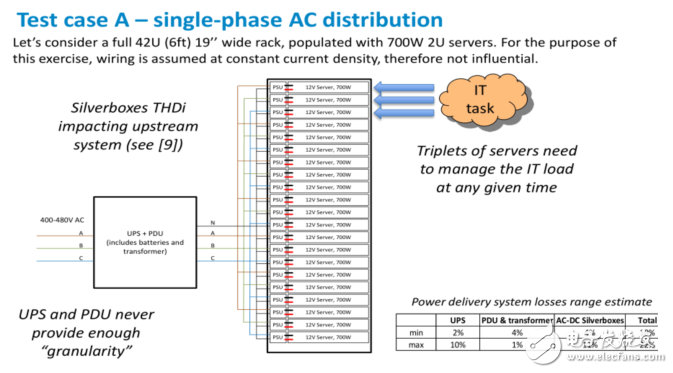
Power efficiency under traditional UPS power supply architecture
With the 48V whole cabinet power supply architecture recommended by Google, UPS and complex power distribution units are no longer needed, and the mains supply is directly supplied to the entire cabinet. The typical loss from the mains to the server board is 7%. Can control losses within 4%.
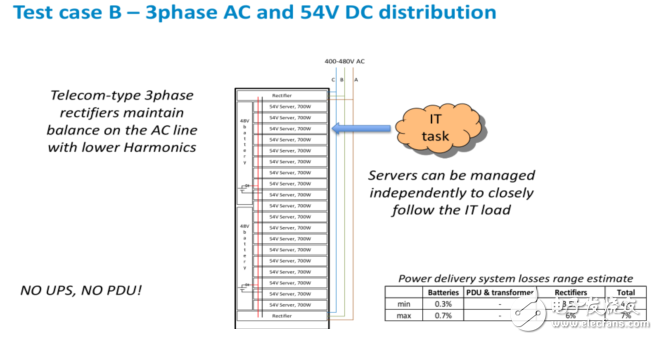
Power efficiency of the traditional 48V whole cabinet power supply architecture
Therefore, compared with the two, the power supply architecture of the 48V whole cabinet with BBU battery pack is compared with the traditional UPS with 12V PSU rack server power supply architecture. The typical system energy saving from the grid to the server board is 15 %.
Let's look at the power supply path from the server board to the CPU. Using the comparison of the energy consumption of the 12V motherboard and the 48V motherboard, here is a typical Vicor product used in the data center as an example to compare the efficiency of the cabinet-level PSU rectifier module, 12V and The transmission loss of the 48V solution on the server board, and the overall efficiency of the 12V or 48V to the step-down POL power supply such as CPU and RAM. From the output of the AC-DC power supply through the connector, the transmission path, and then converted to the final delivery to the processor. For overall efficiency, the loss on the transmission path cannot be ignored. The figure below shows the full path from AC to CPU.
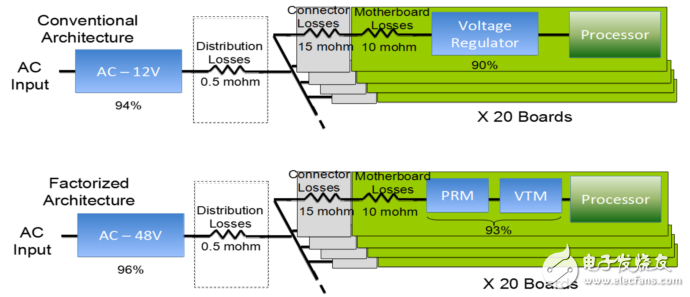
The picture below shows the efficiency comparison of Google at the OCP Summit. In particular, the loss on the path will be further reduced with a 48V power supply architecture.

From the parameters in the above table, we can calculate that the total loss of the 48V power supply is 7.9%, while the loss of the traditional 12V architecture is 10.7%. The loss is reduced by more than 30%.
Vicor's 48V architecture is called FPA (Factorized Power Architecture) and consists of two parts. The front end is a pre-regulator module (PRM) with a buck-boost topology that provides a stable Vf bus voltage and the output voltage responds quickly to changes in load. The back end is a voltage transformer module (VTM) with a patented sinusoidal amplitude converter (STM), which converts the Vf bus voltage to the load point voltage. Its operating characteristics are ideal transformers, which can store energy on the high side capacitor. This greatly reduces the large capacitance of the load point. VTM uses zero voltage, zero current soft switching technology, operating frequency up to 2MHz, with leading power density, Intel Labs tests show that its noise is an order of magnitude lower than the traditional 12V VR, so it can be placed very close to the CPU Place to further reduce the power loss between the power supply output and the CPU power supply pin.

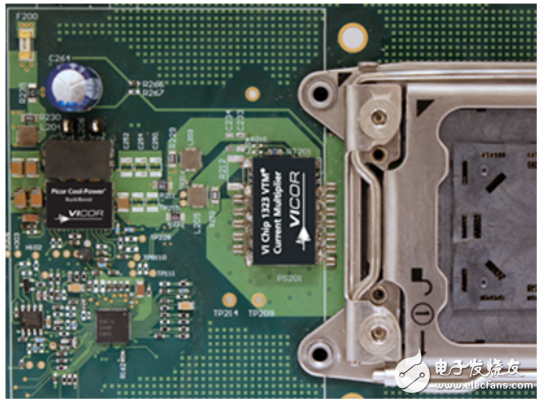
The AC-12V-1V solution is the efficiency of the PSU rectifier module, or the transmission loss on the server board, and the efficiency of the step-down POL power supply is lower than that of the AC-48V-1V power supply architecture. The 12V bus structure is 12KW. The entire cabinet only reached 440W in transmission loss, accounting for nearly 4% of energy consumption. The 12KW cabinet has a current of up to 1000A at 12V output, so even a transmission impedance of 1 milliohm will bring about 1KW of energy (of course, it is possible to reduce the transmission impedance by using a larger copper busbar, but it will bring a larger The volume and higher cost), while using the 48V power supply architecture under the same load power, the voltage is increased by 4 times, the current is reduced by a quarter, and the transmission loss is greatly reduced.
The figure below shows some simple comparisons between the traditional solution and the Vicor FPA solution.
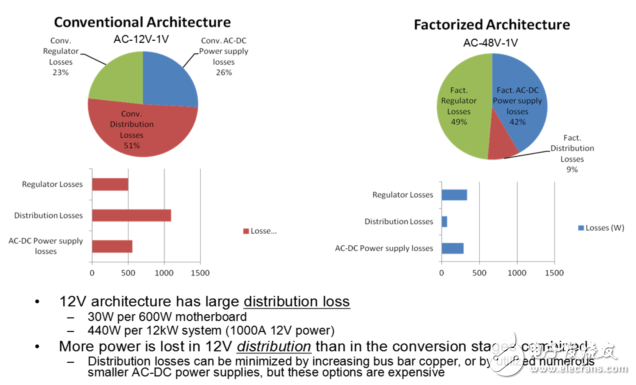
Therefore, for a high-powered whole cabinet, if a 12V intermediate busbar architecture is still used, it will bring a large transmission loss. If the power of a single cabinet is less than 8KW, the loss problem is not obvious, but if the cabinet power reaches 12KW. Above, this transmission loss problem will become more serious, and the 48V bus architecture can support single cabinet power up to 30KW or more, with good future scalability and greatly reduced transmission loss.
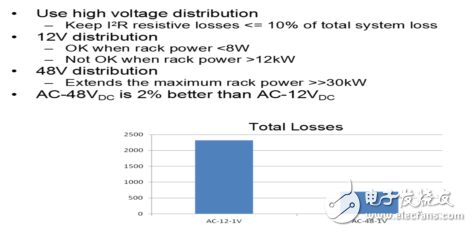
With the development of high-performance computing and applications such as GPUs, the power consumption of servers in the future will continue to increase. If the power of a single cabinet is below 10KW, the 12V bus can barely cope, but as the power of the cabinet increases, the 12V bus will bring Loss and voltage drop will become unbearable, so the bus voltage in the cabinet will definitely develop in the direction of 48V in the future, especially in high-performance computing such as HPC.
As Google announced its intention to join the OCP and contribute its 48V to the OCP, well-known chip vendors announced support for 48V to POL point-of-load and released the corresponding chips. This news has greatly promoted the ecological integrity of the 48V industry chain, indicating that the data center power supply architecture is steadily moving in the direction of 48V. We have already seen that domestic server vendors have launched server verification machines for 48V DC input. I believe that as Google joins OCP to promote the development of this industry, more and more servers and network devices will support 48V in the future. Cabinet ecology.
Finally, we will see the following power trends in the field of data communications.
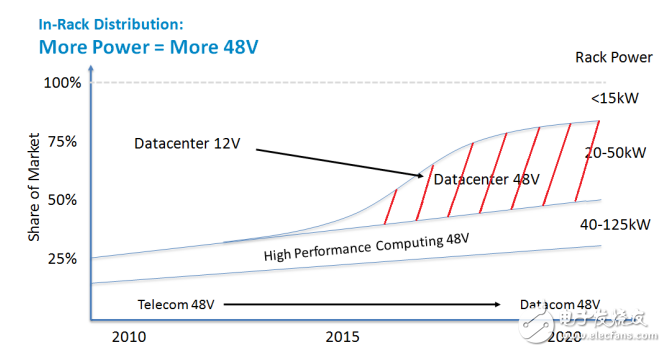
Put the Phone in the leather case , it will protect your phone .We sell Back Cover case,hot selling Back Cover case,leather Back Cover case,etc.
We employ the most creative designers and tech brilliant engineers to make the best cases. We believe our high-quality products with competitive prices will satisfy your needs.
The productive process :
Make the Products Mould –Cutting the fabric –Do the half products – Finish products – Cleaning –QC- Package – Shippment .
For Back Cover case,Back Cover case cover,hot selling Back Cover case,leather Back Cover case
Ysure Leather case 24/7 Support : 86 13430343455 , https://www.ysurecase.com
